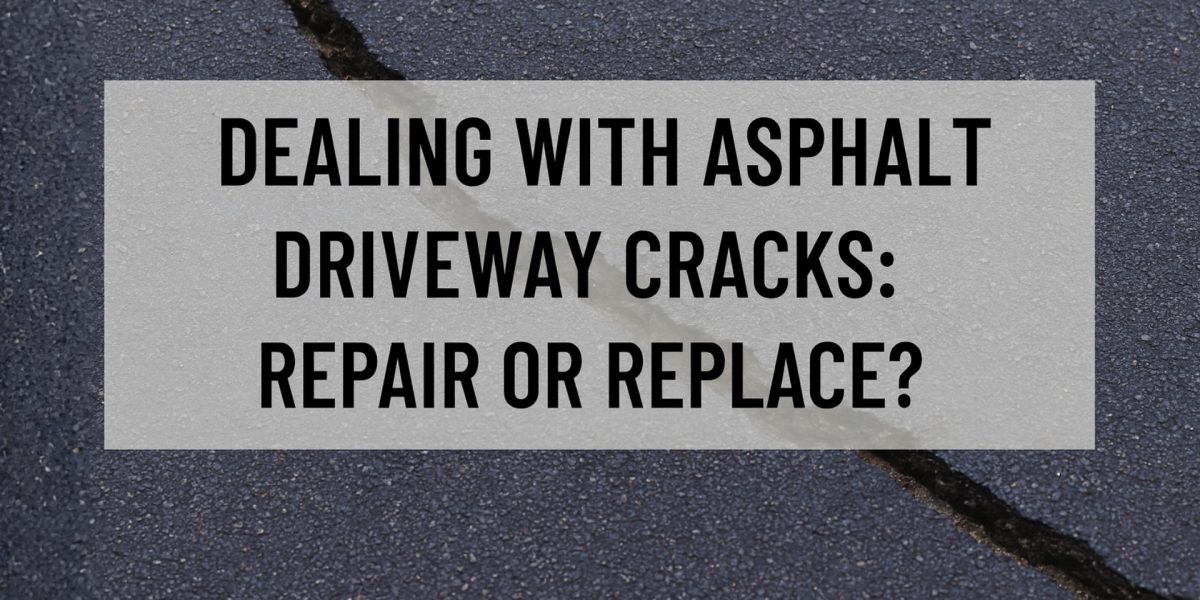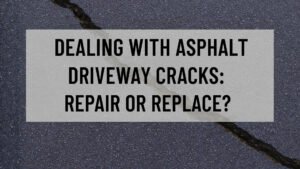Cracked asphalt is more than just an eyesore – small fissures let water and debris penetrate the pavement, causing more damage with each freeze‑thaw cycle. Homeowners often ask whether these cracks are something they can handle themselves or whether it is time to call a professional. As Tex Pave Experts, we’ve spent more than 35 years fixing and building asphalt pavements across North Texas, so we know when a simple fix will do and when more extensive work is needed. Below, we answer common questions about asphalt driveway cracks and explain the steps you can take to protect your investment.
What causes cracks in an asphalt driveway?
Asphalt is a flexible material, but it still reacts to changes in load, temperature, and environment. Researchers from the Mineta Transportation Institute note that cracks can develop for multiple reasons, such as repeated traffic, weather changes, and aging. Expansion and contraction during hot and cold weather cause movements in the pavement; in cold weather, the pavement shrinks and cracks widen, allowing debris and water to enter, while in hot weather, the pavement expands, trapping debris inside and preventing the crack from closing. Over time, these cycles create rough bumps and accelerate deterioration.
Other factors that contribute to cracking include:
- Moisture infiltration and freeze‑thaw cycles. When water seeps into a crack and freezes, it expands and “heaves” the pavement. The University of Minnesota’s Center for Transportation Studies notes that freeze‑thaw cycles let water penetrate and expand in distressed asphalt pavement, leading to cracks and potholes.
- UV exposure and oxidation. Sunlight oxidises the asphalt binder, making the surface dry and brittle over time. Oxidised asphalt is more susceptible to cracking under heavy loads or temperature changes.
- Heavy loads or poor base preparation. Repeated heavy vehicles or an unstable base can cause fatigue cracking, often appearing as alligator‑shaped patterns. The Mineta Institute’s distress manual identifies common crack types such as fatigue, block, edge and transverse cracks – many of these originate from structural issues rather than just surface wear.
- Tree roots and drainage issues. Roots growing under the driveway or poor drainage along the edges can push the pavement upward or wash away sub‑base material, producing uneven settlement and cracks along the borders.
Understanding what is causing your cracks is the first step toward the right repair strategy. A professional inspection can determine whether the problem is mostly surface‑level or whether there are deeper structural issues.
If you are dealing with cracks in an asphalt driveway, what should you do?
Not all cracks are the same, and the right repair depends on their width, depth and extent. Here are practical steps homeowners can follow:
- Inspect and clean the cracks. Remove weeds, dirt and loose debris so you can see the true width and depth of the crack. Cracks that are narrow and not connected to potholes or widespread rutting are usually candidates for sealing or filling.
- Determine the crack type and width. Professional guidelines use the terms working and non‑working cracks. Working cracks open and close with temperature changes, while non‑working cracks show little movement. The Mineta Transportation Institute points out that crack sealing is generally used for working cracks wider than about 1/4‑inch, while filling is used for narrower, non‑working cracks. If you can insert a quarter‑inch (6 mm) object into the crack, sealing may be required; hairline cracks can often be filled with a simple crack filler or sealing product.
- Seal or fill small cracks promptly. Crack sealing prevents moisture from reaching the base and prolongs pavement life. The Seattle Department of Transportation states that crack sealing is a preventive maintenance activity that prevents infiltration of water and other materials and helps maintain streets in good condition. For do‑it‑yourself repairs, choose a quality asphalt crack filler or rubberised sealant, follow the manufacturer’s instructions and apply during moderate temperatures when the crack is open (spring or fall is ideal). Be sure to remove any vegetation and use a wire brush or blower to clean the crack so the sealant adheres.
- Resurface when damage covers a large area. If cracks are numerous, extend across more than about a quarter of the driveway surface, or if the asphalt is significantly oxidised, a thin asphalt overlay (resurfacing) may be more cost‑effective. Resurfacing entails scraping off the top layer and laying a new layer of asphalt over a sound base. Industry guidelines suggest resurfacing can extend an asphalt driveway’s life by 5-10 years, whereas patching alone may last only a couple of years.
- Replace when cracks are severe or structural. Deep cracks wider than 1/4 inch, alligator cracking, large potholes, heaving from freeze‑thaw cycles or a sunken base indicate structural failure. In such cases, sealing or resurfacing will only provide short‑term relief. Replacing the driveway involves removing the old pavement, repairing or replacing the base and installing new asphalt. Although this is more expensive up front, it is often more economical over the long term, especially when the existing pavement is older than 15-20 years or has significant sub‑base damage.
- Prevent future cracks. Preventive maintenance is key. Regularly clean your driveway, apply a high‑quality seal coat every few years and ensure good drainage so water does not pool along the edges. The U.S. Forest Service explains that asphalt seal coat treatments are a preventive maintenance procedure designed to seal and protect the pavement from sunlight, rain and snow and to limit water infiltration. Seal coats won’t fix base failures, but they extend pavement life when the distress is limited to surface deterioration.
Addressing cracks promptly keeps repair costs down and prolongs the life of your asphalt driveway. If you’re unsure of the best approach or if the damage is extensive, it’s wise to consult an experienced asphalt contractor.
Why To Choose Tex Pave Experts?
When you need professional help, selecting the right contractor makes all the difference. Here’s why homeowners across North Texas have trusted Tex Pave Experts for over three decades:
Comprehensive asphalt & paving solutions. We handle everything from minor crack repairs and seal coats to complete driveway replacements and commercial parking lots. Our team will evaluate your driveway’s condition and recommend the most appropriate repair, whether it’s a quick seal job or a full reconstruction.
Local expertise across North Texas. Being based in Texas means we understand the region’s clay soils, heavy rainfall and intense heat. We design and install pavements that withstand North Texas’ unique climate and soil conditions.
Versatility in project scope. Whether you own a residential driveway or manage large commercial lots, we’ve got the expertise and equipment to tackle jobs of any size. From precise patching and crack sealing to large‑scale asphalt paving, we tailor our solutions to your needs.
Commitment to quality & longevity. We use high‑grade materials, follow industry best practices and never cut corners. Our goal is to deliver pavement that looks great and lasts for many years, so you get the best return on your investment.
Customer‑centric approach. We know that driveway repairs can be disruptive. Our team works with you to schedule projects at convenient times, provides clear communication, and ensures that the work area is clean and safe. If you’re searching for the Best Asphalt Contractor Near Me, look no further than Tex Pave Experts through their contact 9725697946 or fill out a form for request a quote for custom needs.
Frequently Asked Questions
Yes. Even narrow cracks allow moisture to penetrate the pavement. Filling hairline cracks with a quality asphalt crack filler prevents water infiltration and stops minor cracks from becoming potholes. According to the Mineta Transportation Institute, sealing or filling cracks reduces moisture intrusion and helps preserve the underlying pavement.
Most driveways benefit from a seal coat every two to three years, but frequency depends on traffic, climate, and the condition of the pavement. The U.S. Forest Service notes that seal coats are a preventive maintenance procedure designed to protect the asphalt surface and limit water infiltration. If your driveway looks faded or the surface feels dry and rough, it’s time to reseal.
If cracks are wider than about 1/4 inch, form an interconnected “alligator” pattern or are accompanied by potholes and base failure, replacement may be the best option. The Mineta Transportation Institute notes that crack sealing is typically triggered when crack width exceeds about 1/4 inch, and that severe cracking often indicates structural issues. A professional evaluation can determine whether resurfacing or full replacement is more cost‑effective.
For small cracks and localized damage, DIY repair is possible. You’ll need to clean the crack thoroughly and use a suitable crack filler or sealer. However, resurfacing and replacement require specialised equipment and expertise. For larger cracks or widespread damage, hiring a professional ensures a durable, long‑lasting result and often saves money in the long run.



